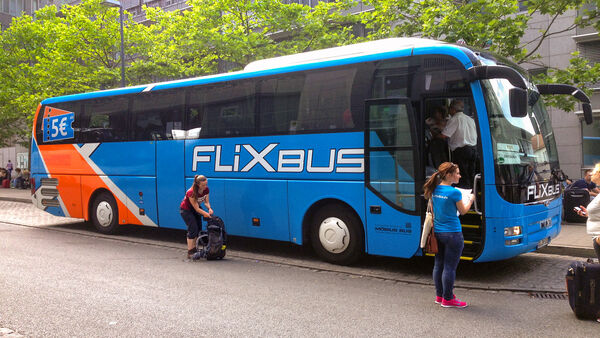Europe’s Long-Distance Buses


By Rick Steves
In most countries, trains are faster, more comfortable, and have more extensive schedules than long-distance buses. But in some places — especially Greece, Turkey, and big parts of Ireland, Croatia, Protugal, the Czech Republic, Spain, and Morocco — buses are often the better (or only) option. And even countries with extensive rail networks may have certain connections where the bus is more direct and/or faster than the train; good guidebooks point these out.
Note that in British English, and therefore in much of Europe's English-language signage and websites, a long-distance bus is called a "coach," while a "bus" provides only in-city transit.
Bus trips are almost always less expensive than trains — often significantly so. In recent years, a flock of new European bus lines have given railways some especially tough competition. For example, a full-fare (second-class) train ticket between Munich and Nürnberg costs about $65 (advance-purchase discounts available), while a bus ticket for this route can be $25 or less (even under $10 if you're willing to buy a few days ahead and aren't picky about departure times).
I use buses mainly to pick up where Europe's great train system leaves off. Buses fan out from the smallest train stations to places trains can't get to. For towns with train stations far from the center (such as Italian hill towns), buses are often scheduled to meet each arrival and shuttle passengers to the main square (often at no extra cost — confirm at the station or with the driver before boarding). Many bus connections to nearby towns not served by train are timed to depart just after the train arrives.
Schedules
In most European countries, bus routes are operated by multiple private companies, each with its own website, timetables, and fares. Aggregator sites like Google Maps, BusBud, GetByBus, and Rome2Rio can help identify bus operators. But finding a reliable, date-specific, and unified source for schedule and price information can be difficult. If you're lucky, the city you're traveling from will have one main bus station that offers consolidated timetables online. But it's more likely that you'll have to check several websites, run by the various companies that serve the cities you're connecting. If you're going from a small town (with no online timetable) to a big city, try checking the "arrivals" schedules on the big city's website instead. Always confirm the schedule in person. Keep in mind that bus service can be less frequent on holidays, Saturdays, and especially Sundays.
Learn to decipher local schedules. For example, in Spain, pista or autopista means the bus takes the freeway — the fastest option. Buses that are directa are faster than those labeled semidirecta or ruta (roundabout journeys with several stops en route). Posted schedules list many, but not all, stops on each route. If you don't see you destination listed, ask at the ticket/information window.
If your trip involves a connection at an intermediate station, it can be difficult to get schedule details for your onward journey. Try contacting the tourist information office in the transfer town (or at your final destination) for help.
Bus Stations
It's common for a big city to have a number of smaller bus stations serving different regions, rather than one terminal for all bus traffic. Sometimes a bus "station" can just be an open parking lot with lots of stalls and a tiny ticket kiosk. Your hotelier or the local tourist information office can usually point you in the right direction.
Larger bus stations have an information desk (and, often, a telephone number) with timetables. In smaller stations, check the destinations and schedules posted on the window of each company's office. Bus-station staffers are less likely to speak English than their train-station staff. Larger bus stations have WCs (often without toilet paper) and cafés that offer quick, forgettable, overpriced food.
Tickets and Passes
For popular routes during peak season, ensure you'll get a seat by buying your tickets online (most upstart bus lines have user-friendly apps) or in person at the station (drop by a few hours in advance to buy tickets). If the station isn't central, you can ask at the tourist information office where to buy bus tickets.
If you arrive in a city by bus and plan to leave by bus, it's smart to check schedules for your outbound trip and perhaps buy your ticket when you arrive. Keep in mind that a few railway-operated buses are covered under certain rail passes (and in Switzerland all buses are covered by the Swiss Travel Pass).
Riding the Bus
Before you get on a bus, ask the ticket seller and the conductor if you'll need to transfer. When you transfer, look for a bus with the same name/logo as the company you bought the ticket from.
For long trips, your ticket may include an assigned seat. If your bag doesn't fit in the overhead storage space, you may be required to check it under the bus (sometimes for a small fee). In most of Europe, smoking is not allowed on buses.
Drivers may not speak English. Buses generally lack toilets, but they stop every two hours or so for a short break. Drivers announce how long the stop will be, but if in doubt, ask the driver. Listen for the bus horn as a final call before departure.
Package Bus Excursions
One-day bus tours from big cities into the countryside are designed for sightseeing but can also serve as useful transportation. For example, rather than buy a train ticket from London to Bath (about $40), consider taking a one-day bus tour from London (about $130) that visits Salisbury, Stonehenge, and Bath. Bring your luggage and leave the tour in Bath before it returns to London, having enjoyed a day of transportation, good sightseeing, and a live guide bubbling with information. It can be well worth the extra cost, and it's more efficient and faster than lacing together the stops on your own, using a combination of trains and public buses. If you do take a bus tour as transportation, confirm the order of stops with the company (will they be stopping at your end destination last?), and check your plans with them.

